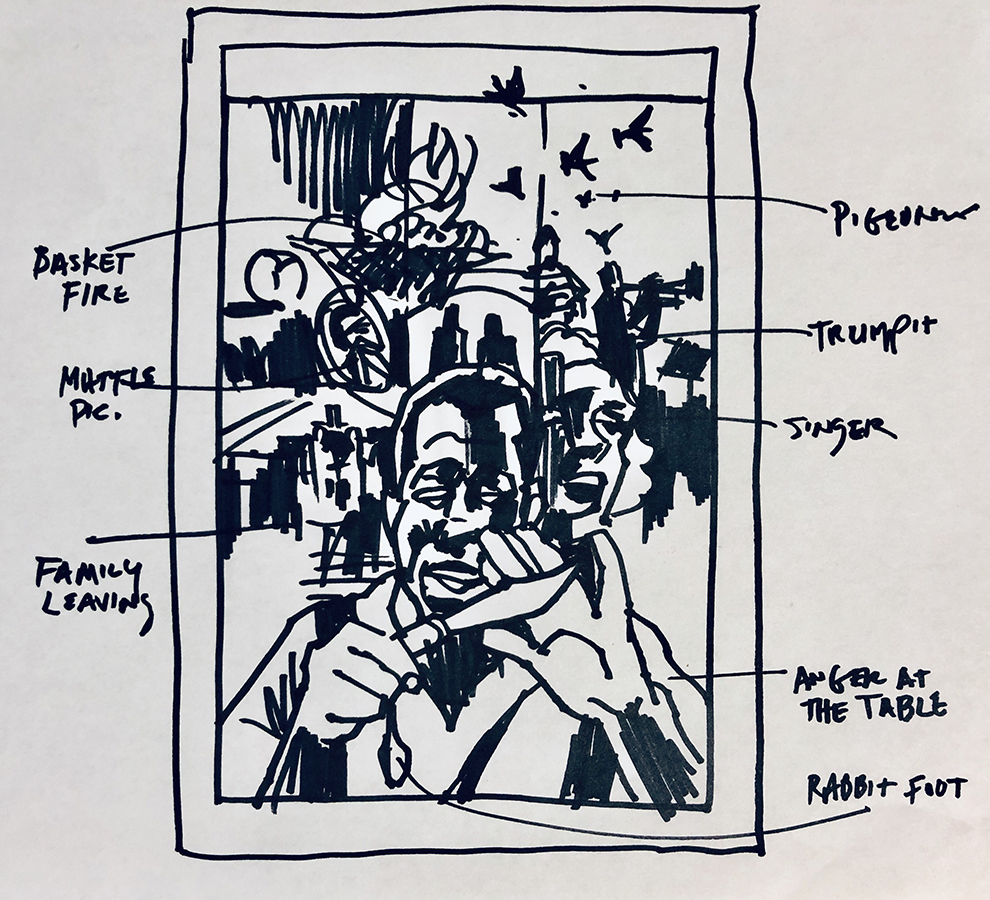Transposing To Sleep with Anger to Paint

Thanks to Charly Palmer, our edition of To Sleep with Anger certainly catches the eye. The Atlanta-based artist, who illustrated our cover for Charles Burnett’s long-underseen 1990 film, has for years been renowned for his vibrant, densely layered depictions of African American history and experience. And it was the intricacy and vitality of his work, much of which draws on social iconography and incorporates bits of text in a collagelike fashion—including group portraits of subjects as varied as musicians at work, voters in line, and picketing protesters that are often emblazoned with significant dates, slogans, and other words—that led Criterion art director Eric Skillman to reach out to him about To Sleep with Anger, a tale of family and tradition as thematically dense as Palmer’s paintings and illustrations. The image that the artist ultimately came up with is a tribute to Burnett’s vision, capturing the poetic-realist film’s complexities in a sprawling, warmly hued mosaic of scenes and symbols that communicate the film’s offbeat folkloric tone and hint at the broad contours of its plot (in which Danny Glover’s enigmatic southern charmer threatens to pry apart the family he pays an unexpected visit in South Central Los Angeles). With the edition of To Sleep with Anger out now, we called Palmer to talk about the process of creating the cover.
Tell us what made you want to take on this commission. It’s such an amazingly dense, energetic image that you came up with, and I imagine there were a lot of layers to its conception.
One of the things I’ve always wanted to do, and that’s why I went to school, is book covers and movie posters. When Eric contacted me initially about doing the illustration, it was one of those things, I’m sure, of finding me on social media, because I’d never done it before, and inquiring whether or not I’d be interested in doing it. What I loved about it is that I had seen the movie years ago. I loved it, but I had never dissected it. So having to go back and revisit the movie was very helpful to me, and also informative. I saw it was a very complicated story. I submitted several rough sketches initially, and because there is so much going on in the movie, I felt that a montage was the best way to depict it.
I read that you often paint from photographs as well. Did you use them during this process?
Very much so. I had to do a lot of screen captures. And that was the other reason I watched the movie probably five or six times. I made notes as to where certain things took place, because I was trying to figure out moments in the movie where it changed or shifted. The challenge was to limit the amount of things I depicted—you don’t want to tell the whole story. But there are [images] throughout the movie that keep coming up . . . and they must be symbolic of something, so I had to find a way to tie those into the overall story. In one scene, the main character explains an ongoing theme throughout the story, and it was the aha moment, so that had to be a part of my illustration. It’s the kid playing a trumpet. Someone says something like, “That kid playing the trumpet is irritating, but in order for him ever to become good at it, he has to play over and over again.” And that makes perfect sense. It’s about learning your craft. In the beginning it’s not going to be the greatest thing, but in that effort you may someday achieve greatness. That’s a very important message throughout the whole story.
What are some of the other things, just in the experience of watching the film, that you knew you wanted to convey on the cover?
I think a very crucial moment is the arrival of the main character, when he first enters the doorway, and how it sets a mood of discomfort . . . That arrival shifted everything in the movie, and so that became very important to the whole story. And then there was an energy between the main character and the mother’s best friend. You got a sense from watching the story that they had a past. So I wanted her to be in the illustration . . . If you look at the scene of the woman to the right [on the cover], it looks like she may be screaming—she’s actually singing. I want you to get an uncertainty about what her emotion is at that moment. That was very intentional—you don’t know unless you’ve seen the movie. That’d be one of the things that’d entice you to see the movie: What is she screaming about? What is she upset about?

Early sketches of the cover illustration








